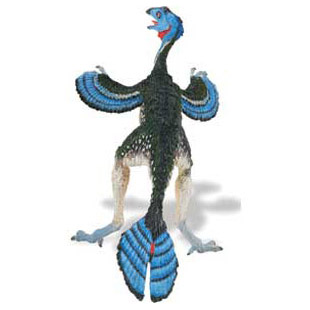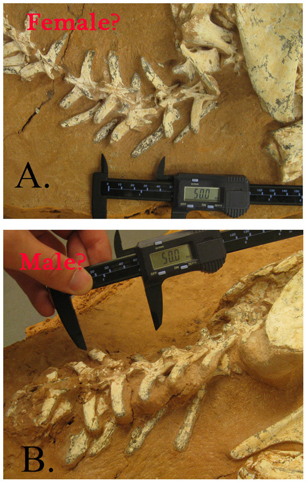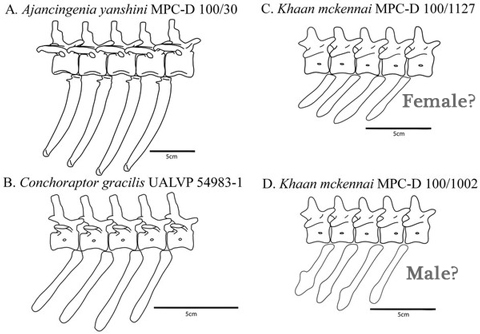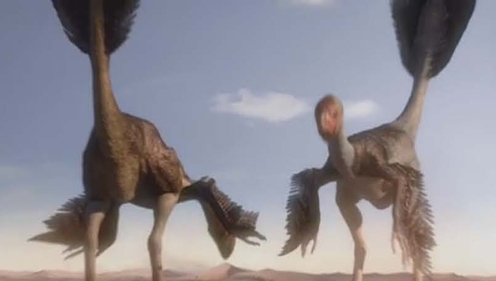Evidence to Support an Oviraptoridae Hypothesis – A Tale of Dinosaur Tails
Being able to tell the girl dinosaurs from the boys is one of the challenges facing palaeontology today. The fossilised bones of long extinct creatures rarely provide clues as to whether an individual was male or female. However, a team of scientists at the University of Alberta have published a paper in the academic journal “Scientific Reports” that provides evidence of sexual dimorphism in the tails of two oviraptorids.
Oviraptorid Study
Oviraptorids (Family Oviraptoridae), are a group of very bird-like theropod dinosaurs, whose fossils are known from Late Cretaceous strata of the Northern Hemisphere, most notably Asia. In many ways, these dinosaurs were anatomically very similar to modern Aves (birds) and it is very likely that these light, agile dinosaurs were covered in a down of insulating feathers.
A Typical Member of the Oviraptoridae (Caudipteryx zoui)
Picture credit: Everything Dinosaur
Dinosaur Feathers
Other kinds of feathers are associated with these types of dinosaurs. For example, long, symmetrical feathers on the forearms and on the end of the tail. In an earlier paper reported upon by Everything Dinosaur in 2013, one of the University of Alberta scientists, proposed that fossils from a type of oviraptorid known as Khaan mckennai might show evidence of fused tail bones, a sort of dinosaur equivalent of a bird’s pygostyle (five fused caudal vertebrae at the very end of the tail).
The scientist who conducted this study, Scott Persons, hypothesised that these types of dinosaurs may have had plumes and tufts (as depicted in the Caudipteryx picture above), these appendages could have formed a display function, just like the fan of feathers found in extant peacocks for example.
To read more about this research: Shaking their Tails and Strutting Their Stuff.
In addition, the young researcher, who conducted this study for his Masters thesis, postulated that one day dinosaur fossils might be found that show different types of tail structure and this might help palaeontologists to work out which fossils represent males and which ones females. Funny he might have thought that…
Dinosaurs
That’s exactly the conclusion reached by the research team, having examined the near complete fossilised remains of two oviraptorids found fossilised together. The fossils represent two specimens of Khaan mckennai, one of which is the holotype for this species. The remains of these two dinosaurs were found within twenty centimetres of each other, they both represent adult animals and as a result they were nicknamed “Romeo and Juliet”, the star-crossed lovers from Shakespeare. They were also named “Sid and Nancy” after the punk rock singer and his girlfriend.
These two little dinosaurs died together when a sand dune, destabilised by heavy rain collapsed and buried them both. The fossils came from the Djadokhta Formation of the Gobi desert (Mongolia) and although one specimen is missing elements from the middle and posterior part of the tail, the Canadian based researchers have identified differences in the shape, size and structure of chevron bones associated with the end of the tail. One specimen has longer tail bone chevrons and these end in a broad tip.
The Fossilised Tail Bones of the Oviraptorids Compared
Picture credit: University of Alberta/Scientific Reports
“Romeo” and “Juliet”
Commenting on the research Scott Persons stated:
“We discovered that, although both Oviraptors were roughly the same size [femur lengths of 19.5 cm and 19 cm respectively], the same age and otherwise identical in all anatomical regards “Romeo” had larger and specially shaped tail bones. This indicates that it had a greater capacity for courtship displays and was likely a male. By comparison the second specimen “Juliet” had shorter and simpler tail bones, suggesting a lesser capacity for peacocking, and has been interpreted as a female.”
Far be it for scientists to speculate, but this could be the preserved remains of a mated pair, a couple of dinosaurs who lived together and died together some seventy-five million years ago. The fossils are part of the Mongolian Academy of Sciences palaeontological collection, fossil reference MPC-D 100/1127 is the holotype material for Khaan mckennai and believed to be a female by the University of Alberta scientists. Whilst, fossil specimen MPC-D 100/1002 with its larger and differently shaped tail chevrons is regarded as a male.
Diagrams Showing the Morphology of the Two Specimens and Comparisons with Other Oviraptorids
Picture credit: University of Alberta/Scientific Reports
Differences in the Caudal Vertebrae
The differences in the tail bones can’t be explained by individual variation between animals of the same species and it is not thought the differences are due to trauma such as an injury, the dissimilarity could be due to sexual dimorphism and therefore if the tail bones of oviraptorids are present, this could be a method whereby scientists can distinguish between males and females, certainly amongst the Oviraptoridae anyway. Further analysis of the known fossil record for this large family of dinosaurs along with more fossil discoveries will be needed to help support this hypothesis.
Scientists Might Be Able to Distinguish between Male and Female Gigantoraptors
Picture credit: BBC (Planet Dinosaur Television Series)










Leave A Comment